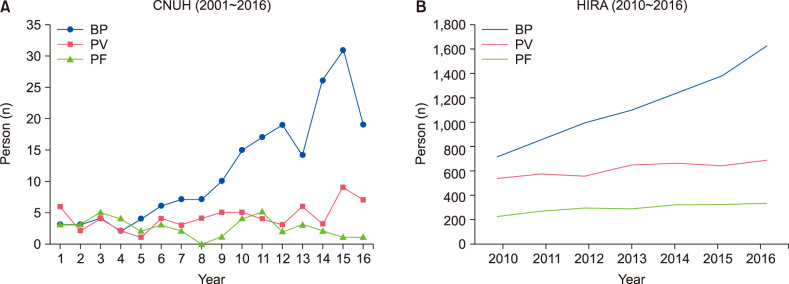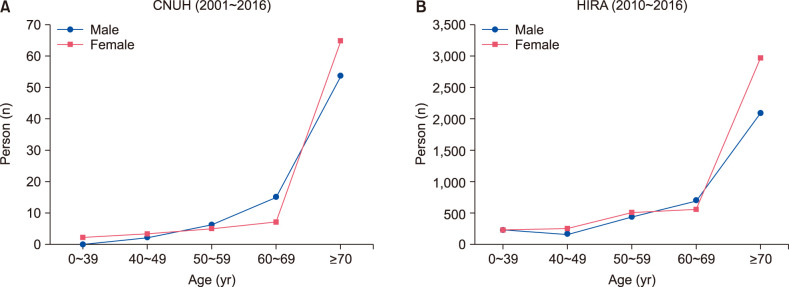Dear Editor:
Bullous pemphigoid (BP), pemphigus vulgaris (PV), and pemphigus foliaceus (PF) are autoimmune disorders that cause blistering of the skin and mucous membranes; they are characterized by the presence of tissue-bound and circulating autoantibodies. Few studies focusing on the incidence of these disorders have been reported1,2,3,4,5.
Through this study, we aimed to evaluate the incidence of BP and compare with the incidences of PV and PF in Korea, as the primary endpoint5. In addition, we sought to compare the incidences of patients with BP, PV, and PF with those of age- and sex-matched statistical data using the Health Insurance Review & Assessment service (HIRA) from 2010 to 2016.
Information regarding all newly diagnosed cases of BP and all cases of the pemphigus group that occurred at Chonnam National University Hospital (CNUH) in Gwangju, Korea, between 2001 and 2016 was collected. In total, 296 patients (160 male and 136 female) with these autoimmune bullous diseases, with a diagnosis based on clinical, histological and immunopathological criteria, were finally included. The study was approved by the Institutional Review Board of the Chonnam National University Hospital (IRB no. CNUH-2021-028), and informed consent was obtained.
A total of 187 patients with BP (ICD-10 codes L12.0), 68 patients with PV (ICD-10 codes L10.0), and 41 patients with PF (ICD-10 codes L10.2) were identified. The incidence of BP increased with time; the average annual rate of increase in incidence was 1.67 (incidence rate ratio=1.11; 95% confidence interval [CI], 1.1~1.2). In contrast, the incidence of pemphigus group did not show any significant change; the average annual rate of increase in the incidence of PV was 0.22 (incidence rate ratio=1.04; 95% CI, 1.0~1.2) and that of PF was 0.19 (incidence rate ratio=1.02; 95% CI, 1.0~1.2). The incidence rate ratio was the incidence rate among the exposed portion of the population, divided by the incidence rate in the unexposed portion of the population, and the average annual rate of increase was calculated by dividing the number of events by at-risk person-years.
As shown in Fig. 1, the incidence of BP in both our cohort and the general population tends to be in general agreement. This result could be attributed to the increasingly aging Korean population since 2010 and the advanced diagnostics and improved awareness regarding the disease.
Fig. 1. Incidence of bullous pemphigoid, pemphigus vulgaris and pemphigus foliaceous in Chonnam National University Hospital (CNUH) (A), and Health Insurance Review & Assessment service (HIRA) (B). The incidence of bullous pemphigoid in both our cohort and the general population has increased significantly in the last 16 years, particularly since 2010. BP: bullous pemphigoid, PV: pemphigus vulgaris, PF: pemphigus foliaceus.
In addition, the incidence of BP increases significantly over time in proportion to aging, and the risk for BP increases rapidly beyond the age of 60 years4. This trend is similar to the results of statistical data from age- and sexmatched controls from the HIRA (Fig. 2). In the recently published national literature, the incidence and mortality rates of PV and PF have increased in older age5.
Fig. 2. Age- and sex-specific incidence of bullous pemphigoid based on data obtained from Chonnam National University Hospital (CNUH) (A) and Health Insurance Review & Assessment service (HIRA) (B). The incidence of bullous pemphigoid in both groups has increased significantly in proportion to aging, especially in individuals aged above 60 years.
This study was the first to determine the actual incidence rate of BP, PV, and PF in Korea using a nationwide population-based database. Our patient cohort is sufficiently large to establish BP as the most frequent autoimmune bullous disease. Based on its significantly increasing incidence, more attention should be paid to BP as a public health concern.
Footnotes
CONFLICTS OF INTEREST: The authors have nothing to disclose.
FUNDING SOURCE: None.
DATA SHARING STATEMENT
Research data are not shared.
References
- 1.Langan SM, Smeeth L, Hubbard R, Fleming KM, Smith CJ, West J. Bullous pemphigoid and pemphigus vulgaris--incidence and mortality in the UK: population based cohort study. BMJ. 2008;337:a180. doi: 10.1136/bmj.a180. [DOI] [PMC free article] [PubMed] [Google Scholar]
- 2.Marazza G, Pham HC, Schärer L, Pedrazzetti PP, Hunziker T, Trüeb RM, et al. Incidence of bullous pemphigoid and pemphigus in Switzerland: a 2-year prospective study. Br J Dermatol. 2009;161:861–868. doi: 10.1111/j.1365-2133.2009.09300.x. [DOI] [PubMed] [Google Scholar]
- 3.V'lckova-Laskoska MT, Laskoski DS, Kamberova S, Caca-Biljanovska N, Volckova N. Epidemiology of pemphigus in Macedonia: a 15-year retrospective study (1990–2004) Int J Dermatol. 2007;46:253–258. doi: 10.1111/j.1365-4632.2006.03010.x. [DOI] [PubMed] [Google Scholar]
- 4.Hübner F, Recke A, Zillikens D, Linder R, Schmidt E. Prevalence and age distribution of pemphigus and pemphigoid diseases in Germany. J Invest Dermatol. 2016;136:2495–2498. doi: 10.1016/j.jid.2016.07.013. [DOI] [PubMed] [Google Scholar]
- 5.Lee YB, Lee JH, Lee SY, Kim JW, Yu DS, Han KD, et al. Incidence and death rate of pemphigus vulgaris and pemphigus foliaceus in Korea: a nationwide, population-based study (2006–2015) J Dermatol. 2018;45:1396–1402. doi: 10.1111/1346-8138.14667. [DOI] [PubMed] [Google Scholar]
Associated Data
This section collects any data citations, data availability statements, or supplementary materials included in this article.
Data Availability Statement
Research data are not shared.




